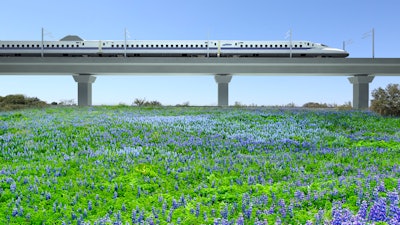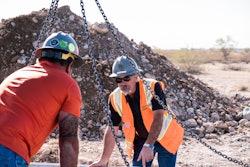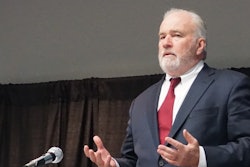 By elevating major portions of the Texas high speed rail project, the designers avoid slowdowns and dangerous at-grade crossing points.
By elevating major portions of the Texas high speed rail project, the designers avoid slowdowns and dangerous at-grade crossing points.California’s much hyped, much criticized high-speed bullet train has run off the rails, and the reasons why make interesting comparison to a still viable high-speed rail project linking Houston and Dallas, Texas.
Newly elected California Gov. Gavin Newsom made the announcement Monday, and on Tuesday the Texas Central Railroad issued a press release detailing all the ways the two projects are different in philosophy, funding, design and execution.
California’s attempt to link Los Angeles and San Francisco was from the beginning government heavy, government funded, and taxpayer subsidized. The $64 billion cost has been climbing steadily and some projected it could go over $100 billion—all of risk in this to be borne by federal, state and local taxpayers.
The Texas plan, in contrast is estimated to cost $12 billion and is entirely investor owned with a group of entrepreneurs and lenders footing the bill. You can read our first take on the comparison of the two systems here.
California’s plan was for 520 miles of track, three hours of travel time with 15 proposed stations and the routes and stations to be determined by political considerations. The shorter Texas rail project goes for 240 miles, 90 minutes of travel time and just three stops. Significantly, the Texas Central Railroad organization says routes and stops will be determined by market research and consumer demand.
 By limiting the stops to three the Texas project will keep total travel time to a minimum.
By limiting the stops to three the Texas project will keep total travel time to a minimum.Another flaw in the California project was the requirement that the high speed trains share portions of their route with slower passenger and freight trains. California’s design also called for at least 42 at-grade railroad crossings to block traffic and pedestrians. The majority of the Texas line will be run on elevated viaducts and the entire length will be dedicated to just the high-speed trains with no dangerous crossing intersections or slowdowns.
Most puzzling of all perhaps is that California decided it would not choose the train and track technology until after construction started, whereas Texas decided early in the planning process to use the Shinkansen technology which has proven to be a clear winner in high-speed rail projects around the world.
All is not lost for California’s high speed rail dreamers, however. The governor said they would complete the Merced to Bakersfield portion of the project, or as one wag called it, “connecting the state’s right armpit to its left armpit.”
While Los Angeles and San Francisco have a combined population of more than 20 million—a decent sized market—Merced and Bakersfield with Fresno in the middle hold a combined population of barely a million people in the middle of a vast agricultural valley. It’s not clear who the passengers would be for this truncated line.
The Central Valley’s farmers generally don’t have a burning need to move around that fast, and even so, the drive time between the two end points is a relatively quick 1 hour and 43 minutes. Perhaps before they throw any more taxpayer dollars at this boondoggle, they should take a clue from Texas and try a little market research.











